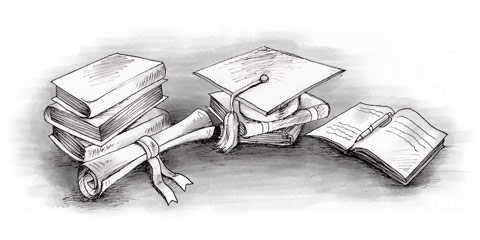Around 15 per cent of Canadians have a university degree, over 25 per cent have a diploma from a post-secondary education institution and around 50 per cent graduate from high school. However, although very few Canadians are illiterate in the sense of not being able to read and write, almost 15 per cent have had only a primary education and a surprisingly high proportion have only marginal literacy skills (although most of these are new immigrants, with limited English- or French-language skills). For example, they cannot use a weather chart to calculate temperature differences, cannot decipher a simple graph or use a bus schedule. Perhaps not surprisingly, native Americans have lower levels of schooling than others and some 55 per cent have no high school diploma and fewer than 5 per cent are university graduates.
Full-time education is compulsory in all provinces and includes the children of foreign nationals permanently or temporarily resident in Canada. However, admission to a public school for foreign children is dependent on the type and duration of the visa granted to their parents, and free schooling may not be available. Compulsory schooling in Canada usually commences at the age of five, six or seven and continues until between the ages of between 16 and 18 (usually the former), although the typical Canadian receives 13 years of education (the average is lower in rural areas and small towns, and higher in metropolitan areas).
Standards and requirements
Education in Canada is the responsibility of individual provinces and districts, therefore standards and requirements vary considerably from province to province and district to district. However, the federal government provides financial support for post-secondary education, adult occupational training and tuition in the two official languages. It’s also responsible for educating native Americans, armed forces personnel and their families, and inmates of prisons and other penal institutions.
Education in public primary and secondary schools is free, but parents must pay ‘student fees’ of between $5 and $100 per term for extra-curricular classes such as music and art. Most students attend public schools, although some 5 per cent attend private fee-paying schools, some of which are church-sponsored, parochial schools (usually Roman Catholic, although in some cities there are others, such as Muslim schools). Most public schools are mixed (co-educational) day schools. Private schools include day and boarding schools and are mostly mixed, although some are single sex. With the exception of some private schools, all education in Canada is non-denominational.
Formal education in Canada comprises three levels: elementary, secondary and higher education. Vocational training, adult education and special schools or classes (e.g. for gifted and handicapped children) also form part of the education programme in most provinces. Foreign families resident in Canada for a limited period may prefer to send their children to a private international school, where the organisation and curriculum are similar to that of public schools, although the administration differs. In recent years, many parents concerned about a decline in public education have turned to private schools. Although the cost of private education is high, many parents consider it an acceptable price to pay, particularly if the outcome is a bachelors or masters degree from a prestigious university. With the exception of most private and some parochial schools, school uniforms are rare in Canada.
Language of Instruction
The language of instruction in most Canadian schools is English, the exception being Quebec where it’s primarily French, although in some communities classes are provided in both languages. For children of Québécois citizens who attend an English primary school, there’s a publicly-supported English school system where English is the language of instruction. All other schools in Quebec teach in French and most children attend French schools irrespective of the language spoken at home. Each year some 30,000 migrant children enter Canada speaking neither English or French and must start their education in special language units or special schools. If your children don’t speak English or French fluently, enquire whether English or French as a Second Language (ESL/FSL) classes are available or whether study is available in other languages. In some major cities children can be taught in foreign languages, e.g. in Vancouver some schools teach in Cantonese, Japanese, Korean and Punjabi.
Many provinces and communities provide schools or special classes for children with special educational needs, including those with emotional and behavioural problems, moderate and severe learning difficulties, communication problems, partial hearing or physical handicaps. There are also private schools in Canada catering for gifted and talented children, and most public schools have gifted and talented programmes.

